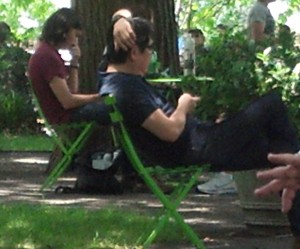Piriformis syndrome and sitting in chairs.
Piriformis syndrome is a pain in the butt caused by the piriformis muscle pressing against the sciatic nerve.
The sciatic nerve is the longest nerve in the body and it passes the piriformis muscle on its way down the leg.
Piriformis syndrome differs from sciatica in that sciatica manifests as pain that originates in the lumbar spine. It often radiates down in a similar fashion to piriformis syndrome but it starts in the lower back.
Piriformis syndrome and sitting are a problem because it is literally impossible to avoid this muscle when seated.
If you know from yoga poses the piriformis is the muscle that gets stretched in pigeon pose.
If you drive a car the piriformis is at work when you lift and move your leg to get in or out of a car.
The piriformis is a small triangular muscle that connects the leg to the sacrum of the spine (it is the only muscle that does so).
Among its roles are stabilizing the pelvis and externally rotating the leg.
If you tend to stand or walk with your feet turned out it is likely that your piriformis is short. And it is probably weaker than you would like.
But these two factors by themselves don’t create piriformis syndrome.
Most of the world stands and walks like a duck but only a small percentage suffer from piriformis syndrome.
For whatever reasons many people get away with poor movement and posture problems for long periods before things go south.
And some people get away with it forever but it is not something I would bank on.
I am relaxing in Union Square as I write this.
It is a beautiful afternoon and I am sitting in one of the horrible folding chairs that they are kind enough to provide.
How do you sit?
As I sit my upper back is leaning against the top of the chair while my lower back rounds backward. My pelvis is tucked under, shortening and crunching the piriformis muscle.
The pictures in this post are a random sampling but they show how everyone around me is reposed.
Piriformis syndrome and sitting in this position and not compatible.
Sitting in a park for a little while won’t bother most people. But what if you are a desk jockey and sit for eight hours a day. Give or take a couple of hours.
How are you sitting as you read this?
Is your pelvis tucked under or in a neutral position?
Are your feet flat on the floor so your pelvis is balanced?
Are you sitting in a way that is good for the long-term health of your body and spine?
Piriformis syndrome and sitting don’t get along. But you can improve this relationship by sitting with better posture.
Piriformis syndrome and sciatica are only two of the many issues that arise from poor movement patterns and posture.
Try to check in with how you are sitting a couple of times during the day and honestly assess how you treat your spine.
A healthy and pain-free life is available to everyone who wants to learn about how the body is supposed to work.
Learning to sit correctly can decrease the odds of getting piriformis syndrome exponentially.
While piriformis syndrome and sitting in chairs will never be compatible, sitting well can mitigate some of the negative effects.




